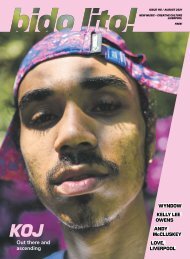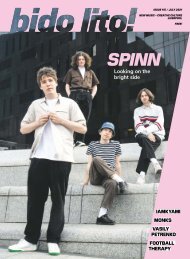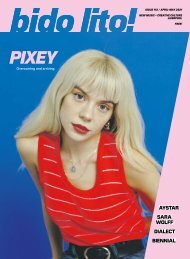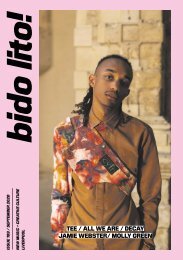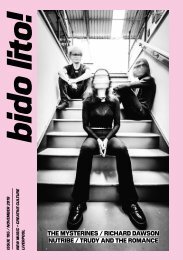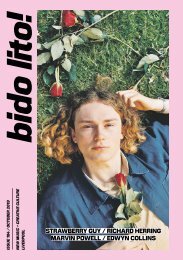Issue 60 / October 2015
October 2015 issue of Bido Lito! Featuring XAM VOLO, JOHN JOSEPH BRILL, IMMIX ENSEMBLE, LIVERPOOL MUSIC WEEK 2015 PREVIEW and much more.
October 2015 issue of Bido Lito! Featuring XAM VOLO, JOHN JOSEPH BRILL, IMMIX ENSEMBLE, LIVERPOOL MUSIC WEEK 2015 PREVIEW and much more.
Create successful ePaper yourself
Turn your PDF publications into a flip-book with our unique Google optimized e-Paper software.
SOUND MATTERS<br />
In this monthly column, our friends at DAWSONS give expert tips and advice on how to achieve a great<br />
sound in the studio or in the live environment. Armed with the knowledge to solve any common (or unusual)<br />
musical problem, the techy aficionados provide Bido Lito! readers with the benefit of their experience so you<br />
can get the sound you want.<br />
Here, sound specialist Harry Brown discusses how to achieve an authentically retro sound by looking at rock<br />
‘n’ roll origins, New Romantic roots and equipment which enables you to lay down tracks in your own home.<br />
There are some products we sell as a store that<br />
could be viewed as ‘forward-looking’, incorporating<br />
the latest technology and perhaps making it more<br />
accessible for many musicians to perform and record<br />
their music. But we also have a stock of retro products<br />
that possibly inspired the sound of a generation, as<br />
well as those based on long-discontinued products.<br />
A good example of this is a Shure 55SH microphone,<br />
sometimes referred to as the “Elvis mic” as it<br />
vaguely resembles the Model 55. This microphone<br />
was first designed in the 1940s for vocal clarity in<br />
close proximity to very loud PA speakers, which<br />
meant it had to be very feedback-resistant. It<br />
did this by having a tight pickup pattern (it only<br />
picked up sounds that were present right in front<br />
of the microphone). Its frequency response was<br />
particularly sensitive in the 5-8kHz range, great for<br />
accentuating the intelligibility in the human voice<br />
(the frequencies which help us understand what we<br />
are saying to each other).<br />
Although there are now microphones available that<br />
are widely accepted as having a better tonal balance<br />
for vocals, and have even tighter pickup patterns, this<br />
microphone is still an immensely popular product.<br />
Its evocative, retro look and quite distinctive sound<br />
are still a hit with musicians and sound engineers<br />
the world over.<br />
A little later and a lot more make-up down the line,<br />
the likes of Tears For Fears, Duran Duran and Roxy<br />
Music were out-shining guitar bands everywhere,<br />
making the keyboard the most sought-after<br />
instrument for many years. Roland's Jupiter 8<br />
synthesiser was the weapon of choice, being used<br />
to good effect for the soft, pad-like keyboards heard<br />
on Roxy Music's hit Avalon.<br />
Today, one of Roland's flagship keyboard products<br />
is the Jupiter 80. Heavily modelled on the look of<br />
the original Jupiter keyboards, it has a retro look<br />
but incorporates a whole host of features that the<br />
original models did not. The eight synth voices,<br />
each comprised of two VCOs, can be layered on top<br />
of any sound from the library of ‘real’ instrument<br />
sounds. Throw in the powerful effects section and<br />
the ability to have all your live keyboard sounds at<br />
your fingertips and there might no longer be the<br />
need for those 15 keyboards that Rick Wakeman<br />
was frequently surrounded by.<br />
The pop/rock bands of the last decade, exemplified<br />
by bands such as The Killers, have relied upon more<br />
straightforward synths than a Jupiter, such as the<br />
MicroKorg. This infinitely portable synth is almost<br />
permanently audible throughout The Killers’ album<br />
Hot Fuss and gave rise to a new generation of bands<br />
writing music heavily featuring synth melodies. The<br />
MicroKorg has a programmable 16-step arpeggiator,<br />
which can be heard prominently on the infamous<br />
Frankie Knuckles remix of The Source hit You Got The<br />
Love (Candi Staton not Florence).<br />
As times have moved on, the way musicians record<br />
their music has changed. It is now commonplace for<br />
musicians to record their music in places other than<br />
recording studios. Recording your material at home<br />
now only requires a fraction of the money it would<br />
have cost 20 years ago, while actually still consisting<br />
of the same basic technology. A recording studio<br />
needs an enormous mixing console in case the<br />
band/ensemble all want to record at the same time,<br />
a rack of A/D converters connected to a powerful<br />
computer, and several sets of amplifiers and<br />
monitoring speakers to help the engineer balance<br />
the mix as accurately as possible.<br />
In a home-studio situation where you are unlikely<br />
to be recording any more than one performer<br />
at a time, you need all the same technology as<br />
the big recording studio, but on a much smaller<br />
scale. Also, some of the technology required can<br />
be condensed down to fewer physical pieces of<br />
equipment. For example, a Focusrite Scarlett 2i4<br />
is both your preamplifier/mixing console and your<br />
set of converters (two channels’ worth), at a very<br />
reasonable price, by the same company that have<br />
designed some of the most highly acclaimed mixing<br />
consoles and mic preamps ever built. Then your rack<br />
of amplifiers needed to power your monitor speakers<br />
could be done away with altogether by purchasing<br />
self-powered or ‘active’ monitor speakers, such as<br />
Yamaha's HS8s.<br />
So, wherever or whenever you are, it is possible to<br />
capture the same great sounds of any classic decade<br />
of music.<br />
Dawsons are offering 10% off lots of products in<br />
their extensive range at their Liverpool store (14-16<br />
Williamson Square). Further details can be found on<br />
pages 4 and 5. dawsons.co.uk<br />
up as straight pop songs to which you would<br />
gladly listen at home, whilst still retaining<br />
their experimental nature.<br />
Though the closure of The Kazimier has<br />
perhaps been over-lamented within these<br />
fine pink pages and generally across the<br />
board of Liverpool music publications, it<br />
is worth noting that it is hard to imagine<br />
witnessing such an adventurous and<br />
impressive double-bill in other venues. Not<br />
that this city is lacking in forward-thinking<br />
venues that will jump at the chance to fill the<br />
inevitable vacuum that the Kaz will leave, but<br />
such unique events could not really have a<br />
better home. But songs about fish will always<br />
find a place in which to prosper.<br />
MARVIN POWELL<br />
Cavalier Song – Hazy Head<br />
Bido Lito! Social Live @ Aloft<br />
Alastair Dunn<br />
Inside a Downton-meets-Star Trek woodpanelled<br />
room with futuristic halo lights<br />
hanging from the ceiling, people recline in<br />
beanbags, hotel staff mill around and HAZY<br />
HEAD’s bassist politely asks the sound guy<br />
if they can play. One guitar, one bass, one<br />
drum kit makes for a classic garage set-up.<br />
Their music is a mix of shoegaze, Hank Marvin<br />
guitar and, oddly, Julee Cruise. Each song<br />
sounds intended for a long-lost David Lynch<br />
movie; a dreamy slow pace is set as the guitar<br />
play practically crashes against the shore. The<br />
set culminates with a cover of Galaxie 500’s<br />
Marvin Powell (Mike Sheerin / michaelsheerin.photoshelter.com)<br />
Tugboat, as Hazy Head wear their influences<br />
on their collective sleeve. Admittedly they<br />
have a couple of cock-ups, but you can see<br />
these guys know what they’re doing and lo-fi<br />
is on the way up.<br />
CAVALIER SONG are next to take to the<br />
carpeted floor. A more disparate group this<br />
time, but as with all great experimental bands<br />
they’re brought together by the music. Joined<br />
by local performance artist Mark Greenwood<br />
and his poetry, they subject us to a diverse<br />
set of noisy assaults and slow-burning<br />
spoken-word pieces. The bass suddenly<br />
breaks during the first track and I notice that<br />
the hi-hat is also cracked, intentionally, I<br />
hope. Greenwood’s lyrics match the sinister<br />
dread the band oozes perfectly, weaving a<br />
fantastical tapestry of people, nature and<br />
their darker halves.<br />
MARVIN POWELL’s love of music is further<br />
apparent (he’s been sat enthusiastically<br />
watching all the supports) as he sings and<br />
jigs along with the folk strains trickling from<br />
the sound system. Suddenly the room fills<br />
with family, friends and fans. I overhear his<br />
mother chatter excitedly about him practising<br />
at home and his Bido feature article. He’s a<br />
local lad and there’s a lot of the love in the<br />
room for the troubadour. Marvin begins<br />
suddenly, the crowd silenced by his guitar,<br />
and anticipation seeps in. His voice takes<br />
on a Celtic quality, the music is folk through<br />
and through. His band soon join him, and the<br />
tempo is kicked up a notch. As the closing<br />
song ends his fans, old and new, call for more<br />
and we’re treated to one final solo piece.<br />
Local talent is clearly in rude health.<br />
Kieran Donnachie





